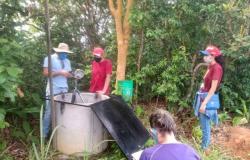Data from Fiern indicate that Rio Grande do Norte had a favorable trade balance in the first two months of this year. Photo: José Aldenir / Agora RN
With a 23.3% increase in exports from Rio Grande do Norte in January and February compared to the same period of the previous year, what drove the growth in the number were sales of fuel oils, according to the technical manager at the International Center for Business (CIN) of the Federation of Industries of Rio Grande do Norte (Fiern), Luiz Henrique Guedes.
The two months ended with a surplus of US$54.9 million, a value that represents the difference between the value of exports, which was US$137 million, and that of imports, which was US$82.1 million. However, the number representing the first two months of 2024 was even lower than the value for the same period in 2023, a surplus of US$72.9 million, US$17.9 million greater than in 2024. The data are from Fiern International Business Center (CIN).
Fuel oils, melons, watermelons, sugar and salt were, respectively, the products with the highest export values, according to a survey carried out by Fiern. However, if the value that fuel oils represent is disregarded, there was a 0.6% drop in the sum of other products exported by the state. Fuel oils alone increased by 111.8% compared to the first months of 2023, in addition to representing 36.5% of the total exported by RN, meaning a total value of US$50 million in fuel oil sales.
In February 2024 alone, melon exports grew 29.8% compared to the second month of last year. However, for January and February, compared to the same period in 2023, there was a decrease of 2.4%, driven by the intensity of rain, according to Guedes.
“The months of January and February, in which melon exports saw a small drop, are the final part of the harvest that began in August last year, which has grown by 11.8% to date. This reduction at the beginning of the year is due to heavy rains that affected the durability of the fruits and, therefore, exports decreased. The harvest lasts until the end of March and beginning of April,” he reported.
For economist Janduir Nóbrega, the state can now expect an improvement in growth, especially when talking about fuel oils. “In the oil and gas and lubricants scenario, the RN market has shown growth, which will probably continue for a while longer, as oil producing companies have increased their production. So this will continue, that is, a greater range of participation in exports from Rio Grande Norte for these products,” he said.
He also mentions that, with the expectation of an increase in exports, there is a possibility of growth in production and job creation. “The more you sell abroad, the more benefits you will generate here in the state, because consequently, to increase production you need to increase the production force, which is hiring, generating income, generating new jobs, so the warming of the trade balance leads to to that”, he reports.
The economist also characterized Rio Grande do Norte as a “slightly poor” state, because, according to him, RN has great production potential, but it is not what is reflected in the economic indicators. “90% of Brazil’s sea salt production is in the state of Rio Grande do Norte, irrigated fruit farming is the third largest in Brazil, RN is the largest exporter of shrimp farming in the country. We have all this wealth being worked on, but it still doesn’t appear in the state, in the economic indicators, in the generation of RN’s Gross Domestic Product. We have export potential, production in different segments. We have a port problem, we have an airport problem, we have a road problem and all these difficulties in infrastructure mean that a promising state in development has its process [de crescimento] slower than it should be, from an economic perspective”, he concluded.
However, it is not just exports that can have an impact on the economy of Rio Grande do Norte. According to the technical manager at (CIN/Fiern), imports of wind energy generators can also add to the expansion of activity in the state. “In 2023, imports of solar panels predominated. As for imports of gasoline and diesel, they are part of market movements that meet the need for supply, since Brazil imports around 30% of what it consumes of these fuels. Wheat is a traditional item on RN’s import list and serves the processing industries, which supply the market with wheat flour used in many products,” he said.
But when talking about export expectations, Guedes mentions that RN can expect even more impacts from sales outside of fuel oils, however, for the melon and watermelon harvest, the return should only occur in August. “Considering the great diversification of the agenda, it is difficult to make a general projection, but fuel oil exports should continue to impact the agenda due to the high values involved”, he concluded.






